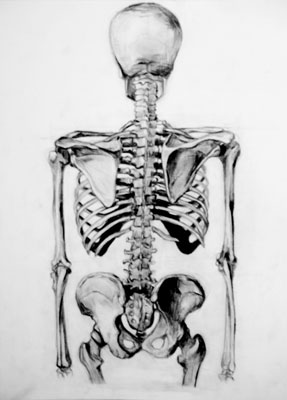All Nonfiction
- Bullying
- Books
- Academic
- Author Interviews
- Celebrity interviews
- College Articles
- College Essays
- Educator of the Year
- Heroes
- Interviews
- Memoir
- Personal Experience
- Sports
- Travel & Culture
All Opinions
- Bullying
- Current Events / Politics
- Discrimination
- Drugs / Alcohol / Smoking
- Entertainment / Celebrities
- Environment
- Love / Relationships
- Movies / Music / TV
- Pop Culture / Trends
- School / College
- Social Issues / Civics
- Spirituality / Religion
- Sports / Hobbies
All Hot Topics
- Bullying
- Community Service
- Environment
- Health
- Letters to the Editor
- Pride & Prejudice
- What Matters
- Back
Summer Guide
- Program Links
- Program Reviews
- Back
College Guide
- College Links
- College Reviews
- College Essays
- College Articles
- Back
How To Protect Your Bones
There is now a window of opportunity for teenagers, especially young women, to prevent a bone disease that results in weak bones susceptible to fractures. Osteoporosis affects approximately 10 million people in the United States alone, 80% of which are women (nof). About 1 in 2 women over the age of 50 will suffer from a fracture as a result of osteoporosis (nof).
Now is the time to reduce your risk of developing osteoporosis. We know how.
1. Exercise: Resistance and weight-bearing exercises
Regular exercise improves health in a myriad areas of your life, from preventing heart disease and cancer to improving brainpower and happiness levels. You can add stronger, healthier bones to that list. Weight-bearing exercises stimulate the production of cells that build up your bone tissue, which are known as osteoblasts (fitness.mercola). Exercises focused on strengthening muscles prevent falls (and fractures that may result) by improving balance and strength (nytimes). Even exercises such as yoga and tai chi have been found to improve balance, strength, and flexibility, decreasing the risk of fractures as well. A combination of exercise types would be most beneficial.
Here are some examples :
High Impact (if you are physically able): Running, jogging, hiking
Low Impact: Elliptical, walking, yoga, tai chi
Resistance (Muscle-strengthening): Weight lifting, weight machines, elastic exercise bands
Note: Talk to your doctor or physical therapist for more information on what is right for you. Perform exercises within your own tolerance, and stop immediately if you feel any pain.
2. Calcium and Vitamin D: Diet or Supplements
A dynamic system influenced by different cells and hormones, bones contain reservoirs of calcium and other minerals. If you do not consume enough calcium, from either food or supplement, your body will release parathyroid hormone to extract calcium from the bones and into the bloodstream. Essentially, your body breaks down your bone in order to obtain minerals necessary for other bodily processes. This can be prevented by obtaining enough calcium and other minerals from other means. Vitamin D helps your body to absorb calcium into the bloodstream (webmd). Low levels of vitamin D contribute to low levels of calcium in the bloodstream. You can obtain more vitamin D through your diet, supplements, or with 10 minutes of sun exposure (protect yourself with sunblock after 10 minutes).
3. No Smoking or Drinking
Bone destruction is another reason to avoid smoking and drinking as both a teenager and an adult, in addition to various cancers and diseases caused by smoking and drinking.
Smoking disrupts the balance of hormones that promote bone health, most importantly estrogen (webmd). This especially affects women in their menopausal years, when a sharp decline in estrogen has already occurred. Estrogen inhibits the activity of cells that break down bone, called osteoclasts, maintaining a balance between the building and breaking down of bone (osteoblasts and osteoclasts). Smoking has been shown to reduce estrogen, thereby increasing the amount of bone broken down by osteoclasts. Alcohol decreases the amount of calcium and vitamin D that is absorbed and decreases levels of estrogen as well.
4. Reduce Salt, Caffeine, and Certain Sodas
You can still drink coffee, soda, and eat salty foods, but not in excess. Caffeine results in a loss of about 6 mg of calcium for every 100 mg of caffeine, which can become an issue if you are not obtaining enough calcium in the first place. Despite that tea contains caffeine, it is suggested that bone-protecting compounds from the tea leaf render it harmless. Many sodas, on the other hand, contain phosphoric acid, which can also lead to calcium loss. Additionally, high-salt diets have been found to result in increased bone mineral loss, especially in post-menopausal women.
Here are helpful guidelines and alternatives (WebMd):
Caffeine: Limit caffeine consumption to 300 mg (while getting enough calcium), which is the equivalent of about 3 cups of coffee (8 fl. oz), depending on how it is prepared. Opt for decaffeinated drinks, but complete elimination of caffeine is not necessary. If you currently consume over 300 mg of caffeine per day, try to reduce your intake.
Soda: Avoid sodas and drinks with phosphoric acid. Opt for milk, smoothies with yogurt, fortified juices, or tea.
Salt: Limit salt to 2,300 mg and under. Most Americans consume over 4,000 mg each day.
5. Other Risk Factors
Eating disorders, such as anorexia and bulimia, weaken bones and can increase your risk for osteoporosis (nof). In addition, if you have any of the previous conditions or have not had your period in over three months and are not pregnant, talk to your parents, doctor, and/or other health professionals as soon as possible (nof). Amenhorrea is a condition involving the atypical absence of your period affects estrogen levels and, as a result, your risk for osteoporosis.
If you are especially thin, have a small frame, or a family history, consider talking to your doctor about your risk for osteoporosis.

Similar Articles
JOIN THE DISCUSSION
This article has 0 comments.
